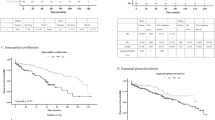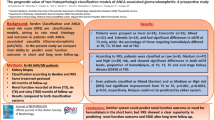Abstract
Background
Immunoglobulin A Nephropathy (IgAN) is a heterogeneous disorder. Multiple ethnicities conducted studies to assess the effectiveness of the Oxford classification of IgAN in prognostication. However, there is no study on the Pakistani population. We aim to identify its prognostic effectivity in our patients.
Methods
We retrospectively reviewed the medical records of 93 biopsy-proven cases of primary IgAN. We collected the clinical and pathological data at baseline and on follow-ups. The median follow-up period was 12 months. We defined the renal outcome as a ≥ 50% decline in eGFR or end-stage renal disease (ESRD).
Results
Of 93 cases, 67.7% were males with a median age of 29. Glomerulosclerosis was the most prevalent lesion (71%). The median MEST-C was 3. On follow-up, median serum creatinine worsened from 1.92 to 2.2 mg/dL, and median proteinuria reduced from 2.3 g/g to 1.072 g/g. The reported renal outcome was 29%. T and C scores and MEST-C scores above 2 were significantly associated with pre-biopsy eGFR. On Kaplan–Meier analysis, the T and C scores’ association was significant with the renal outcome (p-value 0.000 and 0.002). In univariate and multivariate analyses, the association of T-score (p-value 0.000, HR 4.691), total MEST-C score (p-value 0.019), and baseline serum creatinine (p-value 0.036, HR 1.188) were significant with the outcome.
Conclusion
We validate the prognostic significance of the Oxford classification. T and C scores, baseline serum creatinine, and total MEST-C score significantly affect the renal outcome. Furthermore, we recommend the inclusion of the total MEST-C score in determining the IgAN prognosis.


Similar content being viewed by others
Data availability
Data that supports the conclusion can be accessed through references mentioned in the discussion.
References
Moriyama T, Tanaka K, Iwasaki C et al (2014) Prognosis in IgA nephropathy: 30-year analysis of 1,012 patients at a single center in Japan. PLoS One 9(3):e91756
Lee HS, Lee MS, Lee SM et al (2005) Histological grading of IgA nephropathy predicting renal outcome: revisiting HS Lee’s glomerular grading system. Nephrol Dial Transplant 20(2):342–348
MJAjokd H (1997) Histologic subclassification of IgA nephropathy: a clinicopathologic study of 244 cases. Am J Kidney Dis 29(6):829–842
Cattran DC, Coppo R, Cook HT et al (2009) The Oxford classification of IgA nephropathy: rationale, clinicopathological correlations, and classification. Kidney Int 76(5):534–545
Kaihan AB, Yasuda Y, Katsuno T et al (2017) The Japanese histologic classification and T-score in the Oxford classification system could predict renal outcome in Japanese IgA nephropathy patients. Clin Exp Nephrol 21(6):986–994
Kfoury H, Alsuwaida A, Hussain S et al (2014) External validation of the Oxford classification of IgA nephropathy: a retrospective study of 70 patients from Saudi Arabia. Hong Kong J Nephrol 16(2):29–33
Zeng C-H, Le W, Ni Z et al (2012) A multicenter application and evaluation of the oxford classification of IgA nephropathy in adult chinese patients. Am J Kidney Dis 60(5):812–820
Network IN, Cattran DC et al (2009) The Oxford classification of IgA nephropathy: rationale, clinicopathological correlations, and classification. Kidney Int 76(5):534–545
Trimarchi H, Barratt J, Cattran DC et al (2017) Oxford classification of IgA nephropathy 2016: an update from the IgA nephropathy classification working group. Kidney Int 91(5):1014–1021
Yeo SC, Goh SM, Barratt JJN (2019) Is immunoglobulin A nephropathy different in different ethnic populations? Nephrology 24(9):885–895
Haaskjold YL, Bjørneklett R, Bostad L et al (2022) Utilizing the MEST score for prognostic staging in IgA nephropathy. BMC Nephrol 23(1):1–11
Coppo R, Troyanov S, Bellur S et al (2014) Validation of the Oxford classification of IgA nephropathy in cohorts with different presentations and treatments. Kidney Int 86(4):828–836
Serriello I, Polci R, Feriozzi S et al (2015) Extracapillary proliferation is an independent predictive factor in Immunoglobulin A nephropathy. Nephrology (Carlton) 20(9):654–659
Liu Y, Wei W, Yu C et al (2021) Epidemiology and risk factors for progression in Chinese patients with IgA nephropathy. Med Clin (Barc) 157(6):267–273
Bellur SS, Roberts ISD, Troyanov S et al (2019) Reproducibility of the Oxford classification of immunoglobulin A nephropathy, impact of biopsy scoring on treatment allocation and clinical relevance of disagreements: evidence from the VALidation of IGA study cohort. Nephrol Dial Transplant 34(10):1681–1690
Zhang Z, Jiang S-m, Ma Y-p et al (2019) Expression of the intrarenal angiotensin receptor and the role of renin-angiotensin system inhibitors in IgA nephropathy. Mol Cell Biochem 453(1):103–110
Jebali H, Ghabi H, Mami I et al (2020) Prognostic value of the Oxford classification and the Oxford score in IgA nephropathy: a Tunisian study. Saudi J Kidney Dis Transplant 31(6):1366
Alexander S, Varughese S, Franklin R et al (2021) Epidemiology, baseline characteristics and risk of progression in the first South-Asian prospective longitudinal observational IgA nephropathy cohort. Kidney Int Rep 6(2):414–428
Gowrishankar S, Gupta Y, Vankalakunti M et al (2019) Correlation of Oxford MEST-C scores with clinical variables for IgA nephropathy in South India. Kidney Int Rep 4(10):1485–1490
Akhavansepahi M, Rafieyan M, HJJoPe N (2020) Oxford MEST classification in Iranian patients with IgA nephropathy, with regards to extracapillary proliferation; a single center experience. J Preventive Epidemiol. https://doi.org/10.34172/jpe.2020.14
Yeter HH, Gonul I, Guz G et al (2020) Combining clinical features and MEST-C score in IgA nephropathy may be a better determinant of kidney survival. Romanian J Internal Med 58(4):209–218
Aldaoud NH, Alzumaili BA, Marji RD et al (2019) IgA Nephropathy in Northern Jordan: evaluation Using the MEST-C Score of Oxford Classification System. Jordan J Biol Sci 12(1):61–65
Miyabe Y, Karasawa K, Akiyama K et al (2021) Grading system utilising the total score of Oxford classification for predicting renal prognosis in IgA nephropathy. Sci Rep 11(1):3584
Lv J, Zhang H, Wong MG et al (2017) Effect of oral methylprednisolone on clinical outcomes in patients with IgA nephropathy: the TESTING randomized clinical trial. JAMA 318(5):432–442
Rauen T, Wied S, Fitzner C et al (2020) After ten years of follow-up, no difference between supportive care plus immunosuppression and supportive care alone in IgA nephropathy. Kidney Int 98(4):1044–1052
Du Y, Cheng T, Liu C et al (2023) IgA nephropathy: current understanding and perspectives on pathogenesis and targeted treatment. Diagnostics 13(2):303
Acknowledgements
None to declare.
Funding
The authors did not receive support from any organization for the submitted work.
Author information
Authors and Affiliations
Corresponding author
Ethics declarations
Conflict of interest
The authors have no relevant financial or non-financial interests to disclose.
Ethical approval
This study protocol was reviewed and approved by Institutional Review Board and Ethical Committee, Shifa International Hospital, Islamabad (Approval No. IEC/NP-625).
Additional information
Publisher's Note
Springer Nature remains neutral with regard to jurisdictional claims in published maps and institutional affiliations.
Rights and permissions
Springer Nature or its licensor (e.g. a society or other partner) holds exclusive rights to this article under a publishing agreement with the author(s) or other rightsholder(s); author self-archiving of the accepted manuscript version of this article is solely governed by the terms of such publishing agreement and applicable law.
About this article
Cite this article
Saleem, N., Nasir, H., Anwar, F. et al. To evaluate the utility of Oxford classification in predicting renal outcome in IgA nephropathy patients. Int Urol Nephrol 56, 345–353 (2024). https://doi.org/10.1007/s11255-023-03685-z
Received:
Accepted:
Published:
Issue Date:
DOI: https://doi.org/10.1007/s11255-023-03685-z




